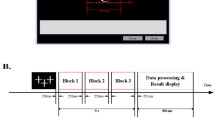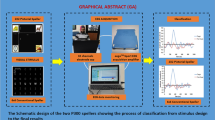Abstract
Objective The stimulus color of P300-BCI systems has been successfully modified. However, the effects of different color combinations have not been widely investigated. In this study, we designed new stimulus patterns to evaluate the influence of color modulation on the BCI performance and waveforms of the evoked related potential (ERP).Methods Comparison was performed for three new stimulus patterns consisting of red face and colored block-shape, namely, red face with a white rectangle (RFW), red face with a blue rectangle (RFB), and red face with a red rectangle (RFR). Bayesian linear discriminant analysis (BLDA) was used to construct the individual classifier model. Repeated-measures ANOVA and Bonferroni correction were applied for statistical analysis. Results The RFW pattern obtained the highest average online accuracy with 96.94%, and those of RFR and RFB patterns were 93.61% and of 92.22% respectively. Significant differences in online accuracy and information transfer rate (ITR) were found between RFW and RFR patterns (p < 0.05). Conclusion Compared with RFR and RFB patterns, RFW yielded the best performance in P300-BCI. These new stimulus patterns with different color combinations have considerable importance to BCI applications and user-friendliness.









Similar content being viewed by others
References
Ahirwal MK, Kose MR (2021) Development of emotional decision-making model using eeg signals evolution in computational intelligence. Front Intel Comp Theory Appl. https://doi.org/10.1007/978-981-15-5788-0_27
Bentin S, Allison T, Puce A, Perez E, McCarthy G (1996) Electrophysiological studies of face perception in humans. J cognit neurosci 8:551–565
Birbaumer N (1999) Slow cortical potentials: Plasticity, operant control, and behavioral effects. Neuroscientist 5:74–78
Blankertz B, Dornhege G, Krauledat M, Mueller K-R, Curio G (2007) The non-invasive berlin brain-computer interface: fast acquisition of effective performance in untrained subjects. Neuroimage 37:539–550
Blankertz B, Lemm S, Treder M, Haufe S, Mueller K-R (2011) Single-trial analysis and classification of ERP components a tutorial. Neuroimage 56:814–825
Cabel DW, Cisek P, Scott SH (2001) Neural activity in primary motor cortex related to mechanical loads applied to the shoulder and elbow during a postural task. J Neurophysiol 86:2102–2108
Cheng J, Jin J, Wang XY (2017) Comparison of the BCI performance between the semitransparent face pattern and the traditional face pattern. Comput Intell Neurosci https://doi.org/10.1155/2017/1323985
Coles MGH, Rugg MD (1995) Event-related brain poten-tials: An introduction. Oxford University Press
Corbetta M, Miezin FM, Dobmeyer S, Shulman GL, Petersen SE (1991) Selective and divided attention during visual discriminations of shape, color, and speed: functional anatomy by positron emission tomography. The J Neurosci The Offic Journal The Soc Neurosci 11:2383–2402
Duncan CC et al (2009) Event-related potentials in clinical research: guidelines for eliciting, recording, and quantifying mismatch negativity, P300, and N400. Clin Neurophysiol 120:1883–1908
Eimer M (2000) Event-related brain potentials distinguish processing stages involved in face perception and recognition. Clin Neurophysiol 111:694–705
Farwell LA, Donchin E (1988) Talking off the top of your head: toward a mental prosthesis utilizing event-related brain potentials. Electroencephalogr Clin Neurophysiol 70:510–523
Feng J et al (2018) Towards correlation-based time window selection method for motor imagery BCIs. Neural Networks 102:87–95
Fernandez-Rodriguez A, Velasco-Alvarez F, Medina-Julia MT, Ron-Angevin R (2019) Evaluation of flashing stimuli shape and colour heterogeneity using a P300 brain-computer interface speller. Neurosci Lett . https://doi.org/10.1016/j.neulet.2019.134385
Grigoryan RK, Krysanova EU, Kirjanov DA, Kaplan AY (2018) Visual stimuli for p300-based brain-computer interfaces: color, shape, and mobility. Moscow Univ Biol Sci Bull 73:92–96
Guo M, Jin J, Jiao Y, Wang X, Cichockia A (2019) Investigation of visual stimulus with various colors and the layout for the oddball paradigm in evoked related potential-based brain computer interface. Front Comput Neurosci. https://doi.org/10.3389/fncom.2019.00024
Halder S, Takano K, Ora H, Onishi A, Utsumi K, Kansaku K (2016) An evaluation of training with an auditory p300 brain-computer interface for the japanese hiragana syllabary. Front Neurosci. https://doi.org/10.3389/fnins.2016.00446
Han D, Dai Y, Han T, Dai X (2015) Explore awareness of information security: insights from cognitive neuromechanism. Comput Intell Neurosci. https://doi.org/10.1155/2015/762403
Hoffmann U, Vesin JM, Ebrahimi T, Diserens K (2008) An efficient P300-based brain-computer interface for disabled subjects. J Neurosci Methods 167:115–125
Huang M, Daly I, Jin J, Zhang Y, Wang X, Cichocki A (2016) An exploration of spatial auditory BCI paradigms with different sounds: music notes versus beeps. Cogn Neurodyn 10:201–209
Huang M, Jin J, Zhang Y, Hu D, Wang X (2018) Usage of drip drops as stimuli in an auditory P300 BCI paradigm. Cogn Neurodyn 12:85–94
Jeffreys DA, Tukmachi ES (1992) The vertex-positive scalp potential evoked by faces and by objects. Exp Brain Res 91:340–350
Jin J, Allison BZ, Kaufmann T, Kubler A, Zhang Y, Wang XY, Cichocki A (2012) The Changing Face of P300 BCIs: A Comparison of Stimulus Changes in a P300 BCI Involving Faces, Emotion, and Movement. Plos One 7. https://doi.org/10.1371/journal.pone.0049688
Jin J, Allison BZ, Sellers EW, Brunner C, Horki P, Wang XY, Neuper C (2011) An adaptive P300-based control system. J Neural Eng. https://doi.org/10.1088/1741-2560/8/3/036006
Jin J, Chen Z, Xu R, Miao Y, Wang XY, Jung T-P (2020a) Developing a Novel Tactile P300 Brain-Computer Interface with a Cheeks-Stim Paradigm. IEEE transac bio-med eng. https://doi.org/10.1109/TBME.2020.2965178
Jin J, Daly I, Zhang Y, Wang XY, Cichocki A (2014) An optimized ERP brain-computer interface based on facial expression changes. J Neural Eng. https://doi.org/10.1088/1741-2560/11/3/036004
Jin J, Horki P, Brunner C, Wang X, Neuper C, Pfurtscheller G (2010) A new P300 stimulus presentation pattern for EEG-based spelling systems. Biomedizinische Technik/biomed Eng 55:203–210
Jin J, Li S, Daly I, Miao Y, Liu C, Wang X, Cichocki A (2020) The study of generic model set for reducing calibration time in P300-based brain-computer interface. IEEE Trans Neural Syst Rehabil Eng 28:3–12
Jin J, Miao Y, Daly I, Zuo C, Hu D, Cichocki A (2019) Correlation-based channel selection and regularized feature optimization for MI-based BCI. Neural Networks 118:262–270
Jin J, Sellers EW, Zhou SJ, Zhang Y, Wang XY, Cichocki A (2015) A P300 Brain-Computer Interface Based on a Modification of the Mismatch Negativity Paradigm. Int J Neural Syst. https://doi.org/10.1142/S0129065715500112
Kaethner I, Kuebler A, Halder S (2015) Rapid P300 brain-computer interface communication with a head-mounted display. Front Neurosci. https://doi.org/10.3389/fnins.2015.00207
Kaufmann T, Holz EM, Kubler A (2013) Comparison of tactile, auditory, and visual modality for brain-computer interface use: a case study with a patient in the locked-in state. Front Neurosci. https://doi.org/10.3389/fnins.2013.00129
Kaufmann T, Schulz SM, Grunzinger C, Kubler A (2011) Flashing characters with famous faces improves ERP-based brain-computer interface performance. J Neural Eng. https://doi.org/10.1088/1741-2560/8/5/056016
Ko Y-H, Shen IH, Lee D-S (2010) Color combinations of visual display terminal (vdt) icon on user preferences and eeg responSE. Percept Mot Skills 110:411–428
Kumarahirwal M, Londhe ND (2012) Power Spectrum Analysis of EEG Signals for Estimating Visual Attention. Int J Comp Appl 42:34–40
Li G-L, Wu J-T, Xia Y-H, He Q-G, Jin H-G (2020a) Review of semi-dry electrodes for EEG recording. J Neural Eng. https://doi.org/10.1088/1741-2552/abbd50
Li S, Jin J, Daly I, Zuo C, Wang X, Cichocki A (2020b) Comparison of the ERP-Based BCI Performance Among Chromatic (RGB) Semitransparent Face Patterns. Front Neurosci. https://doi.org/10.3389/fnins.2020.00054
Li Y, Bahn S, Nam CS, Lee J (2014) Effects of luminosity contrast and stimulus duration on user performance and preference in a p300-based brain-computer interface. Int J Human Comput Interact 30:151–163
Lu Z, Li Q, Gao N, Yang J (2020) Time-varying networks of ERPs in P300-speller paradigms based on spatially and semantically congruent audiovisual bimodality. J Neural Eng 17
Luaute J, Morlet D, Mattout J (2015) BCI in patients with disorders of consciousness: clinical perspectives. Ann Phys Rehabilitation Med 58:29–34
Mehla VK, Singhal A, Singh P (2020) A novel approach for automated alcoholism detection using Fourier decomposition method. J Neurosci Methods. https://doi.org/10.1016/j.jneumeth.2020.108945
Miao Y et al (2020) An ERP-based BCI with peripheral stimuli: validation with ALS patients. Cogn Neurodyn 14:21–33
Nakanishi M, Wang Y, Chen X, Wang YT, Gao X, Jung TP (2017) Enhancing detection of ssveps for a high-speed brain speller using task-related component analysis. IEEE Transac Biomed Eng:1–1
Parra J, da Silva FHL, Stroink H, Kalitzin S (2007) Is colour modulation an independent factor in human visual photosensitivity? Brain 130:1679–1689
Rezeika A, Benda M, Stawicki P, Gembler F, Saboor A, Volosyak I (2018) brain-computer interface spellers: a review. Brain Sci. https://doi.org/10.3390/brainsci8040057
Salvaris M, Sepulveda F (2009) Visual modifications on the P300 speller BCI paradigm. J Neural Eng. https://doi.org/10.1088/1741-2560/6/4/046011
Schwartz EL (1977) Spatial mapping in the primate sensory projection: analytic structure and relevance to perception. Biol Cybern 25:181–194
Sitaram R, Weiskopf N, Caria A, Veit R, Erb M, Birbaumer N (2008) fMRI brain-computer interfaces. IEEE Signal Process Mag 25:95–106
Speier W, Deshpande A, Cui L, Chandravadia N, Roberts D, Pouratian N (2017) A comparison of stimulus types in online classification of the P300 speller using language models. Plos One. https://doi.org/10.1371/journal.pone.0175382
Stemmler M, Usher M, Niebur E (1995) Lateral interactions in primary visual cortex: A model bridging physiology and psychophysics. Science (Washington D C) 269:1877–1880
Sun H, Jin J, Kong W, Zuo C, Li S, Wang X (2020) Novel channel selection method based on position priori weighted permutation entropy and binary gravity search algorithm. Cognitive Neurodynamics. https://doi.org/10.1007/s11571-020-09608-3
Takano K, Komatsu T, Hata N, Nakajima Y, Kansaku K (2009) Visual stimuli for the P300 brain-computer interface: a comparison of white/gray and green/blue flicker matrices. Clin Neurophysiol 120:1562–1566
Townsend G et al (2010) A novel P300-based brain-computer interface stimulus presentation paradigm: moving beyond rows and columns. Clin Neurophysiol 121:1109–1120
Vidal JJ (1977) Real-time detection of brain events in EEG. Proc IEEE 65:633–641
Wolpaw JR et al (2000) Brain-computer interface technology: a review of the first international meeting. IEEE Transac Rehabilit Eng 8:164–173
Wolpaw JR, Ramoser H, McFarland DJ, Pfurtscheller G (1998) EEG-based communication: improved accuracy by response verification. IEEE Transac Rehabilit Eng public IEEE Eng Med Biol Soc 6:326–333
Zhaohua L, Ning G, Weiwei Z, Jingjing Y, Jinglong W, Qi L (2019a) A comparison of facial P300-speller paradigm based on famous face and the familiar face. 2019 12th Int Cong Image Signal Processing, BioMed Eng Inf. doi:https://doi.org/10.1109/cisp-bmei48845.2019.8965892
Zhaohua L, Qi L, Ning G, Taiyue W, Jingjing Y, Ou B (2019b) A Convolutional Neural Network based on Batch Normalization and Residual Block for P300 Signal Detection of P300-speller System. IEEE Int Conf Mech Autom. doi:https://doi.org/10.1109/icma.2019.8816214
Zuo C et al (2020) Novel hybrid brain-computer interface system based on motor imagery and P300. Cogn Neurodyn 14:253–265
Acknowledgements
This work was supported by the National key research and development program 2017 YFB13003002. This work was also supported in part by the Grant National Natural Science Foundation of China, under Grant Nos. 61573142, 61773164 and 91420302, the programme of Introducing Talents of Discipline to Universities (the 111 Project) under Grant B17017, the Ministry of Education and Science of the Russian Federation (Grant 14.756.31.0001) and Polish National Science Center (UMO-2016/20/W/NZ4/00354), and the “ShuGuang” project supported by Shanghai Municipal Education Commission and Shanghai Education Development Foundation under Grant 19SG25.
Author information
Authors and Affiliations
Corresponding author
Ethics declarations
Conflicts of interest
The authors declare that they have no conflicts of interest.
Additional information
Publisher's Note
Springer Nature remains neutral with regard to jurisdictional claims in published maps and institutional affiliations.
Rights and permissions
About this article
Cite this article
Zhang, X., Jin, J., Li, S. et al. Evaluation of color modulation in visual P300-speller using new stimulus patterns. Cogn Neurodyn 15, 873–886 (2021). https://doi.org/10.1007/s11571-021-09669-y
Received:
Revised:
Accepted:
Published:
Issue Date:
DOI: https://doi.org/10.1007/s11571-021-09669-y




